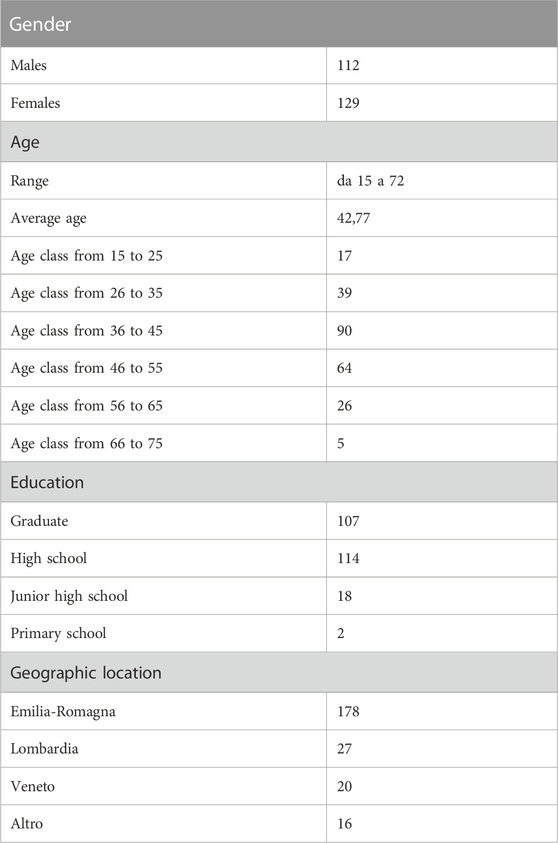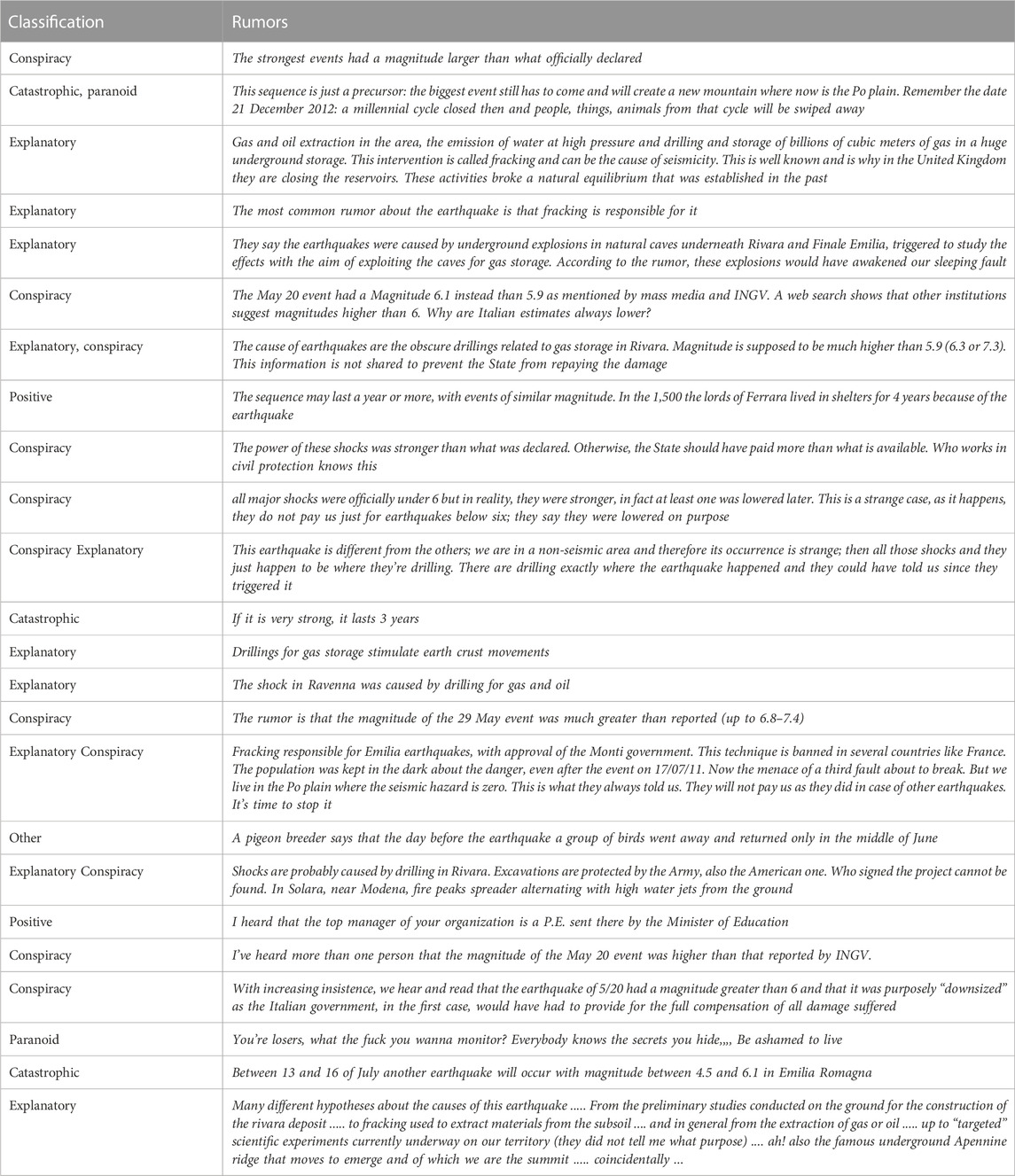- 1Istituto Nazionale di Geofisica e Vulcanologia, Sezione di Roma 1, Rome, Italy
- 2Istituto Nazionale di Geofisica e Vulcanologia, Sezione di Bologna, Bologna, Italy
Controversies that stir the public debate on geological matters usually revolve around a few specific aspects, including the actual trigger of geological phenomena (i.e., natural vs. anthropogenic), their predictability, and the trustworthiness of the experts who provide information and advice on the phenomena. A typical example of such difficulties is the case of the 2012 Emilia, Italy, seismic sequence which struck an area of relatively moderate seismic hazard. In that period, geophysical prospecting was planned to assess the potential of a reservoir for gas storage, near the town of Rivara. The low frequency of important seismic events in the area, associated with the ongoing industrial planning prompted widespread rumors of an anthropogenic origin of the 2012 earthquakes. Controversy also arose about the actual size of the seismic events: earthquakes magnitude can be computed with different methods, and its value depends on the type, number, and geographical distribution of the available seismic stations. As a result, different institutions commonly release different estimates of the earthquake magnitude, casting doubts on the reliability of each estimate. Since 2012, public concern has also been caused by the repeated occurrence of unusual phenomena in the area, such as ground heating or bubbling well waters. Popular belief tends to establish a causal link between particular phenomena and seismic activity, reinforcing the false conviction that seismicity could be predicted. In this work we present and discuss some of the activities that INGV pursued through the years to contrast rumors and disseminate correct scientific information. In the aftermath of the 2012 seismic sequence, INGV worked in collaboration with the National Department of Civil Protection, the local administrations, the University Network of seismic engineering, the Regional Healthcare System and local volunteer organizations. The organization of public meetings, the collection and analysis of widespread rumors and the creation of ad hoc outreach materials all contributed to reinforce the mutual trust between our research institute and the local population.
1 Introduction
On 20 May 2012 (02:03:53 UTC), a magnitude (Mw) 5.86 earthquake (Ml=5.9) hit the Po plain, in Italy, causing five casualties and damage in several towns, including Modena and Ferrara. Three hours earlier, a Mw 4.0 foreshock (Ml 4.1) struck the same area. These events initiated a seismic sequence that included six more shocks above magnitude 5.0, the greatest of which occurred on 29 May 2012 (07:00:03 UTC), had a magnitude Mw 5.7 (Ml 5.8) and was located 12 km to the west of the May 20 event (Figure 1). After this second mainshock, the death toll rose to 17 victims, while 13,000 people had to be evacuated. The economy of this wealthy, industrial area of Northern Italy was seriously impacted.
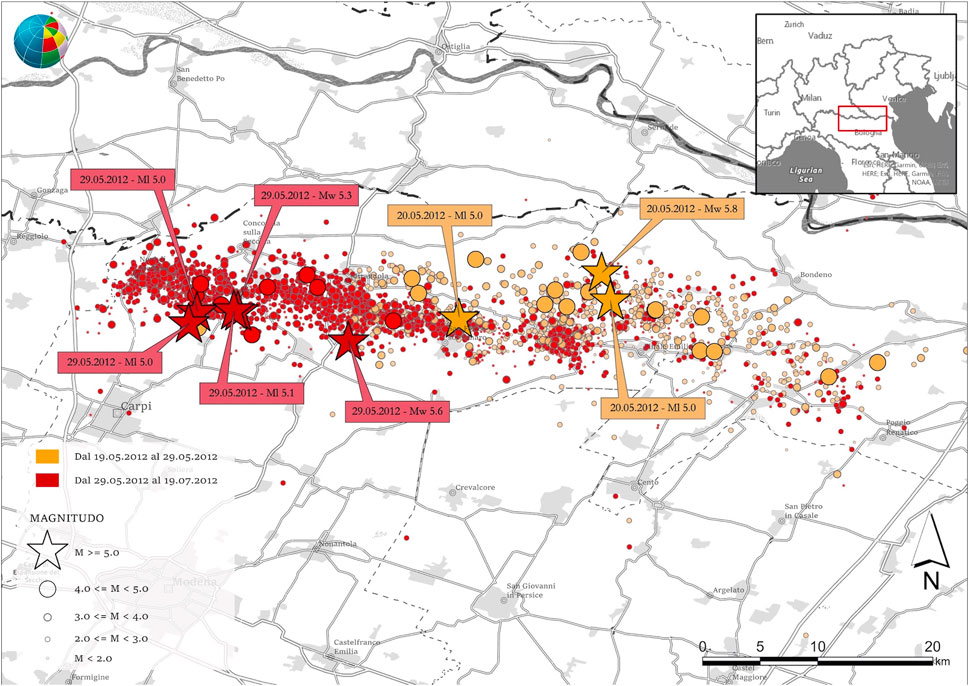
FIGURE 1. The main shocks of the 2012 Emilia Romagna seismic sequence. The size of the points reflects the magnitude, as shown in the legend. For the six greatest events (stars), the labels report the date (day.month.year) and the magnitude. The image is taken from a blog article published on the INGVterremoti blog on the 10th anniversary of the sequence (modified after https://ingvterremoti.com/2022/05/21/terremoti-in-pianura-padana-10-anni-dopo-i-numeri-della-sequenza-e-la-dashboard/).
The occurrence of a strong earthquake increases the social awareness toward natural hazards, and commonly prompts a strong demand for information (Bossu et al., 2015). The need for a continuous flow of details becomes urgent, especially during prolonged seismic sequences. The availability of correct and exhaustive information affects people’s capacity to cope with emergency situations, and may foster the resilience of single individuals and of the entire communities involved. On the contrary, the lack of timely and accurate information may favor the circulation of rumors and misinformation (Fallou et al., 2020). A good communication among different stakeholders during a crisis may improve the community response to the emergency and reduce the costs of the disaster. However, scientific communication also promotes a rational and transparent decisional process and facilitates the acceptance of the disaster consequences (Wendling et al., 2013).
However, science communication is not always straightforward in the aftermath of a natural disaster. In addition to the scientific complexity, which may hinder a proper understanding of the natural phenomenon, the scientific information provided may fail to address the specific fears and needs of the population at risk, adding to their frustration. The stressful circumstances emphasize the emotional reactions of the stakeholders involved, and the technical staff may be unprepared to cope with the irrational components of human interactions. Under these circumstances, fake news may grow and spread, and if not promptly addressed, may cause unwanted consequences (Lamontagne and Goulet, 2018; Fallou et al., 2020).
Nowadays, the need to fight earthquake rumors while ensuring a prompt and exhaustive flow of information is widely recongnized in the seismological community (Fallou et al., 2022). In this paper, we describe how our Institute (Istituto Nazionale di Geofisica e Vulcanologia, INGV) has worked to address this complex issue in particular after the 2012 seismic sequence, by promoting different kinds of actions. Proposed interventions were all aimed at engaging the local population in a fruitful knowledge exchange, and have been structured around three main principles: connect, listen, and share. The underlying concept is that knowledge transfer works when it is a mutual exchange, and where the scientific information that is released to the public is suited to address the public’s questions and fears.
Accordingly, the first response to the seismic sequence was the organization of public meetings, which were held in different locations, upon request from local authorities, from May to September 2012 (Figure 2). These public encounters were realized thanks to the joint efforts of the Italian Civil Protection Department (DPC), INGV, and the regional administrative authority (Regione Emilia-Romagna), in collaboration with the Laboratory University Network of seismic engineering (RELUIS), the Regional Healthcare System and the organizations of civil protection volunteers. The meetings were announced locally with flyers and taking advantage of all channels available to the participating stakeholders (including announcements broadcasted on local radio or TV networks and institutional websites). Based on the fruitful experience carried out after the 2009 L’Aquila earthquake (Nostro et al., 2009; Moretti et al., 2011), the campaign was named “Earthquake: let’s talk about it” and provided suitable spaces where citizens could meet the experts from the organizing institutions, receive information about the seismic sequence and its effects, and express their doubts and fears related to the earthquake. All these public meetings allowed ample space for open questions and informal discussion among the participants, providing a useful psychosocial support as the seismic sequence unfolded, accompanied by growing false information and urban legends.
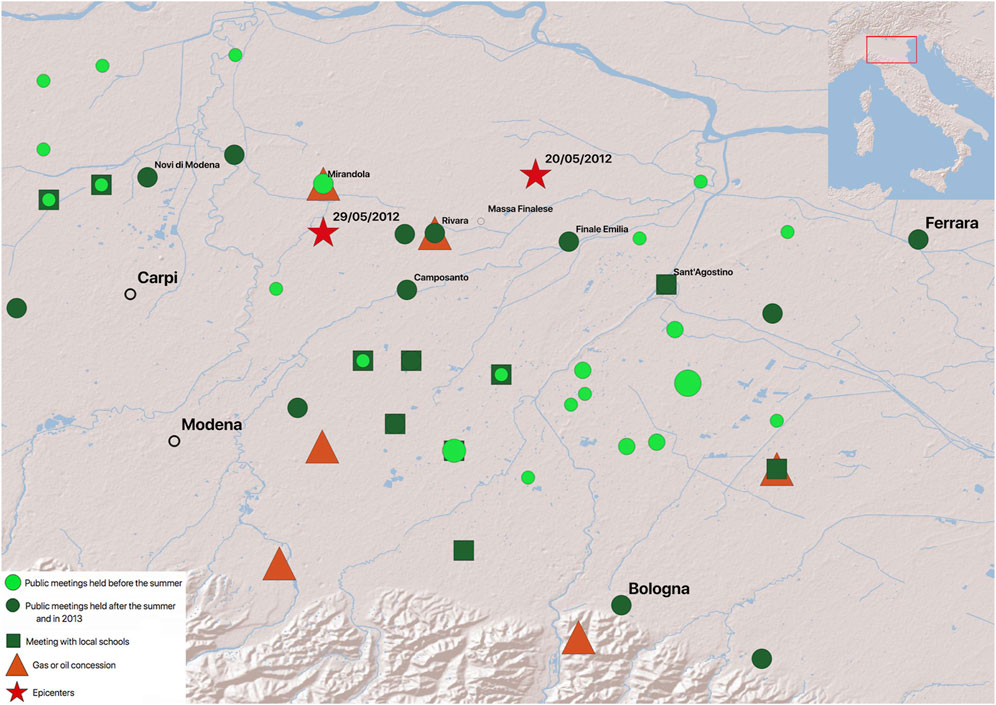
FIGURE 2. Locations of the public meetings organized in the region affected by the 2012 seismic sequence. The red stars indicate the two major events, on May 20 and 29, 2012. Orange triangles show the location of gas or oil concessions. Green symbols indicate the locations of the public meetings organized during and after the sequence. The size of the symbols reflects the number of meetings held at each location, with larger symbols corresponding to 5 encounters. Light green symbols indicate meetings held during the sequence (before the summer), while darker symbols show meetings organized after the summer. Square symbols refer to activities held in local schools, during the 2012/2013 school year.
Rumors about the ongoing sequence were then collected online, through various institutional websites, and analyzed to gain insights on the scientific information required to address common misconceptions or popular beliefs. Information on the rumor collection was provided during the public meetings, and advertised online. The collection of widespread rumors is a necessary step to counteract its effect, devising appropriate outreach material and providing authoritative and coordinate answers (Lamontagne and Goulet, 2018; Fallou et al., 2022).
On a longer term, the link established with the communities was maintained through different kinds of actions, including sharing of scientific results (through the institutional blog and social media, releasing interviews to traditional media), attending public meetings and cultural events, and participating in school activities. The scientific contents proposed during these outreach activities were tailored to address the specific needs that emerged in the public discourse about the earthquake.
In this paper, we describe the outcome of these combined actions and propose future steps to improve the communication of natural hazards.
2 Materials and methods
Our approach to the communication during the seismic sequence in 2012 was devised in collaboration with other national and local stakeholders, and was organized around three main pillars: connect, listen, and share. We sought a connection with the affected population by creating the conditions suited to allow a free exchange of information, thoughts and fears about the earthquakes. We listened to the questions that circulated among the people, and collected information on the widespread rumors and finally we produced outreach material suited to address those questions and rumors.
2.1 Connect: The psychosocial intervention
The traditional approach to emergency psychology has been primarily oriented toward clinical actions (aimed at both individuals or groups). In recent years, however, the guidelines released by international organizations of the field (Inter-Agency Standing Committee (IASC, 2007) and WHO, in particular) have emphasized more and more the psychosocial impact of the intervention, and its community and intercultural dimensions. Emergency psychology should not only take care of the clinic of single unrelated individuals, but also provide a systemic management of the psychosocial community scenario, where the emergency took place and whence it built its significance. Based on these indications, and taking advantage of the precious experience gathered in the aftermath of the 2009 L’Aquila earthquake (La Longa and Crescimbene, 2009), we organized a series of meetings with the local population. The meetings had different aims: to inform about the seismic sequence; to address people’s anxieties and expectations; to promote resilience by increasing people’s knowledge and self-consciousness (Lamontagne and Flynn, 2014). In particular, the psychosocial intervention was meant to.
• Share basic information about the geological setting of the area and available data about the ongoing seismic sequence.
• Provide basic knowledge about emotions, and individual and group reactions facing an emergency: psychological information was provided side by side with seismological information. The awareness of the state of arousal associated with the emergency allows to recognize the potential susceptibility to rumors, but also to acknowledge the individual and community capacity to cope with the emergency;
• Direct the population toward structures and practitioners capable of providing appropriate social and psychological support. The collaboration with the local public healthcare structures (AUSL) and institutions allowed to build a network of dedicated psychologists and psychotherapists for the population involved. Simple information on where to find these local services were provided during the meetings;
• Discuss and counter rumors and urban legend on the earthquake. A greater people awareness about these rumors contributed to lower the level of anxiety and to reduce the social tension within and between institutions;
• Encourage and promote open discussion where all stakeholders are present simultaneously. The availability of a space to discuss and exchange thoughts and fears has a strong “therapeutic” value and, when properly managed, it allows to ease tensions and conflicts, and represents an essential aid for those affected. Through this systemic approach, and thanks to appropriate listening skills, the emergency can be placed within its reference frame, and resources and responses can be oriented and calibrated according to the needs expressed by the communities affected;
• Favor the active participation of citizens and foster all the initiatives promoted by local communities.
This approach acknowledges the importance of a direct, continuous and empathetic contact with the population (Lamontagne and Flynn, 2014) and overturns a traditional perspective, according to which the authority needs to care for a sick or incapable population. In this case, the Civil Protection system stimulates curative effects toward objects that are damaged or destroyed, and toward responsible citizens: the people capable of taking care of themselves and up to take remedial actions. The community does not need to be rescued, but helped to get up again. An environment that promotes mutual exchange and that warrants timely and accurate information favors the population’s engagement during the emergency and helps harmonize different stakeholders’ perceptions (Wendling et al., 2013).
2.2 Listen: Rumors collection in 2012
Since the very beginning of our activities in the field, it was clear that we needed to address and counter the rumors about the seismic sequence that spread in a massive and uncontrolled way. Specific information on these rumors was considered of utmost importance in structuring the meetings of the campaign “Earthquake, let’s talk about it”.
Allport and Postman (1947) define rumors as faith propositions on specific (or current) topics, which pass from person to person, usually by word of mouth, with no clear evidence of their veracity. Media were shown (Ma, 2008; Dominick, 2010; Herriman, 2010; Doerr et al., 2012; Qin et al., 2015) to have a key role in their dissemination.
With the recent development of technology, especially mobile devices that have made social networks accessible 24/7, the spread of rumors has become faster than ever, regardless of the credibility of this information (Martin et al., 2021). This brings unprecedented challenges in ensuring the reliability of information. The spread of disinformation often occurs in the context of breaking news, where information released gradually often begins as unverified information. For these reasons, the automatic identification of rumors and fake news from online social media, especially microblogging sites, is a very important and current research topic (Zhao et al., 2015; Alzanin and Azmi, 2018; Fallou et al., 2022).
The scientific study of rumors began in America in 1940, when hearsay about the Second World War spread rising concerns about national security and social cohesion. The US government responded by appointing a committee meant to fight the rumors. Social scientists proposed the establishment of the so-called Rumor Clinic: operational facilities developed within the wider Rumor Project, involving several government agencies. Rumors were collected and cataloged throughout the country. Some newspapers, such as the Boston Herald, contributed to the effort, by publishing every week the most common rumor, together with a list of facts to counter it (Allport and Postman, 1947).
To gain information on the rumors spreading after the 2012 seismic events, a collection was carried out online, through the websites of the sponsoring institutions (the National Department of Civil Protection (DPC), the local administrative entity, Regione Emilia Romagna, our institute INGV, Edurisk, a long-term educational project on natural hazards). We devised an online form to acquire standard information about the rumors described by different participants. Web users were asked to report the rumor, together with some additional details on its origin, its perceived reliability and on its spreading patterns (Table 1). Some personal details on the users themselves completed the online survey (Table 2). From 16 June 2012 to 12 October 2012, we collected 241 rumors reports that could be subdivided into five main categories, as better described below.

TABLE 1. Information requested when submitting a rumor report to characterize both the population sample and the collected rumor.
2.3 Share: scientific contents to fight fears
The actions devised to contrast the rumors were designed to increase the critical sensitivity of the population involved. Critical sensitivity may indeed attenuate the rumor’s strength (Chorus, 1953; Bordia and Difonzo, 2004). To reach this goal during the emergency, all the institutions involved in the public meetings with the population agreed on specific actions. Before each public meeting in a specific area, the strongest rumors at that location were discussed and analyzed to devise appropriate answers and information to be shared during the meeting. This approach meant to foster a healthy skepticism and the development of critical thinking by.
• Sharing seismological concepts and information on psycho-social aspects that influence rumors and their propagation (emotion, level of collective anxiety, uncertainty, social psychology mechanisms such as conformism);
• Promoting good practices such as careful checking on the source of information, instead of a blind trust on the news presented by traditional or new media;
• Suggesting that no institution should be considered authoritative a priori (not even those involved in the current information campaign).
After the emergency, the prosecution of outreach activity on themes that were perceived as relevant allowed to keep a strong and healthy relationship with the communities and their local institutions. Dissemination activities carried out in the affected area aimed at addressing the rumors described above. Ad hoc materials were prepared for display and discussed during public encounters of different kinds, including local fairs, public meetings organized by local authorities or cultural associations, science café, lessons in local schools (of all grades) and universities. We also published posts on institutional blogs INGVterremoti (Pignone et al., 2012) and gave interviews to local and national media (press, radio and television).
3 Results
3.1 Meeting with local communities
Based on the approach described above, during the 2012 seismic sequence we organized and held 44 public meetings, between June 4 and 2 August 2012. Figure 2 shows the locations of these encounters that were attended by more than 6,300 people (Figures 3A, D). Eighteen more meetings were conducted in the following months, between September 2012 and April 2013, gathering another 700 people. This activity was flanked by more specific meetings targeting the schools since the opening of the school year, in September 2012: 800 teachers were engaged during 13 meetings (Figure 3B), together with healthcare professionals from the local structures (AUSL, hospitals, Figure 3C). Meeting duration was variable and depending on public response, ranging from 2 to over 3 h. Typically, two or three INGV researchers (both seismologists and psychologists) attended each meeting.
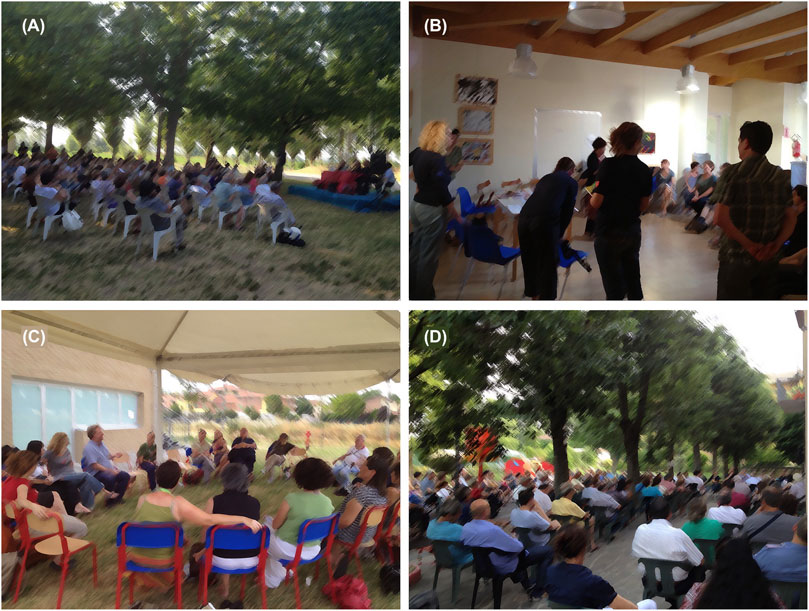
FIGURE 3. Pictures taken during the public meetings at different locations, with the population (A, D) or with teachers (B) and personnel of the national health services (C).
These meetings proved to be very useful to identify the issues that caused concern among the population. The most frequent questions were collected and updated after each meeting, and allowed to produce outreach materials specifically targeted to address people’s worries. Table 3 reports some of these questions. The presence of different stakeholders allowed addressing very different but relevant topics during the same meeting, with the conversation easily spanning from the ongoing natural processes to the measure that can be taken to improve buildings’ resistance to shaking. The availability of an open space with the presence of representatives of different institutions involved in the emergency allowed a public conversation that could address various causes of anxiety, related to both the ongoing seismic sequence and the efficacy of its management. Despite the tangible tension that often accompanied the opening of these encounters, the public discussion allowed expressing fears and doubts and most of the times granted the establishment of a positive bond of trust among various stakeholders involved.
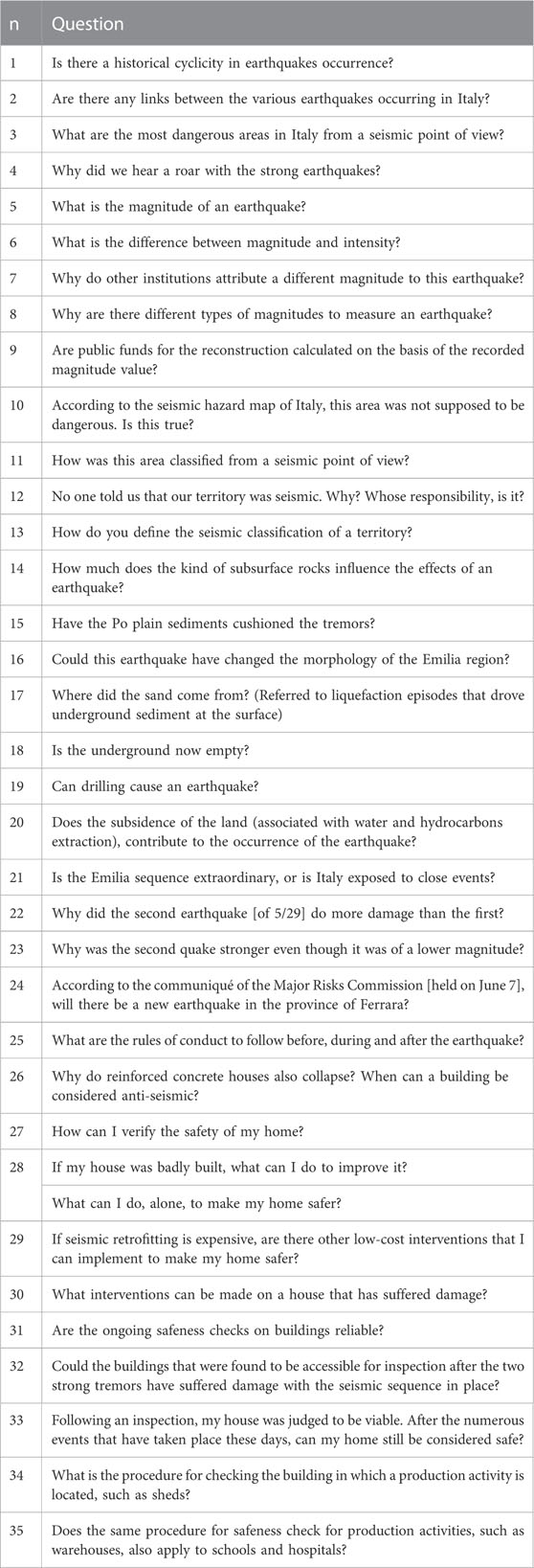
TABLE 3. List of common questions raised during the public meetings organized during and after the 2012 Emilia seismic sequence.
3.2 Analysis and strength of the rumors
We classified the collected rumors into five categories, based on their contents: explanatory, conspiracy, catastrophic, paranoid (i.e. subject to persecution mania), and optimistic. Some of the rumors could fall in two or more categories (see Table 4), and in those cases we arbitrarily assigned the rumor to the first category listed. Figure 4A illustrates their relative proportions, with most of the rumors falling within the first three categories (explanatory, 35%, catastrophic, 29% and conspiracy, 26%), and a few exceptions grouped as “other effects”. This prevalence of rumors with explanatory, catastrophic and conspiracy nature does not change even if rumors falling into more categories are assigned differently, to their second or third category. To classify and compare different rumors, we further analyzed the dataset assigning a score to the origin (O), diffusion (D) and trust (T) of each rumor. We identified three possible origins for the rumors: institutional sources and research institutes; national and local media; individuals and social media. To each source category we assigned a different degree of reliability, ranging from trustworthy (when the rumor originates from institutional sources, score O=1) to unreliable (single individuals, or social media, score O=3). Figure 4B shows how most of the rumors originate from untrustworthy sources. The diffusion of the rumor was assessed based on the number of people the rumor was repeated to, after being heard. We defined three levels of rumor spread (and associated scores): no diffusion (D=1), when the rumor was not reported to anyone else; sharing with a maximum of 6 people; and sharing with more than 6 people (score D=3). The threshold of 6 people stems from the theory of “six degrees of separation”, according to which any person may be connected to any other person in the world through a chain of acquaintances with no more than five or 6 intermediaries (Milgram, 1977). While 33% of the rumors were repeated at least a few times, half of them were shared with more than 6 people (Figure 4C). The last three points of the survey (Table 1) were used to measure the confidence in the rumor. This was done combining three different indicators meant to: measure the degree of belief in the rumor, according to the rumor reporter (T1); check if the content of the rumor was verified by the reporter by consulting other trustworthy sources (T2); and the importance of the rumor content, according to the reporter (T3). The degree of belief T1 was assessed by asking the reporter “Do you believe it?“. The five possible answers (not at all, very little, little, much, very much) were converted into a numeric value ranging from 1 (little, or no trust) to 3 (high degree of belief). The indicator T2 was established from the responses to the question “Did you check or verify the rumor content?“, T2 values could range from 1, when the content was verified by consulting an authoritative source, to 3 if no check was made. The indicator T3 was computed by asking the questionnaire filler “How important is this content for you?“, and ranged from 1 (not important at all) to 3 (very important).
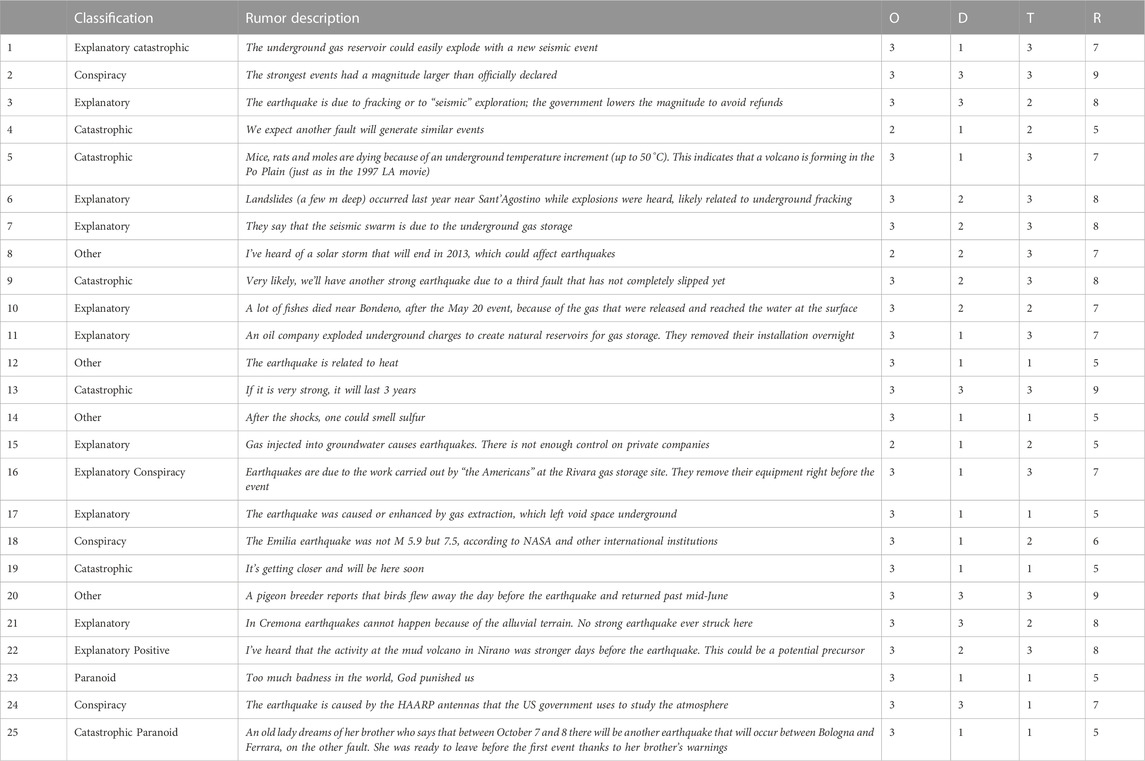
TABLE 4. Excerpt from the list of collected rumors, classified according to their type (explanatory, catastrophic, conspiracy, positive, paranoid, other); their origin (O); diffusion (D), Trust (T) and strength (R). See text for discussion.
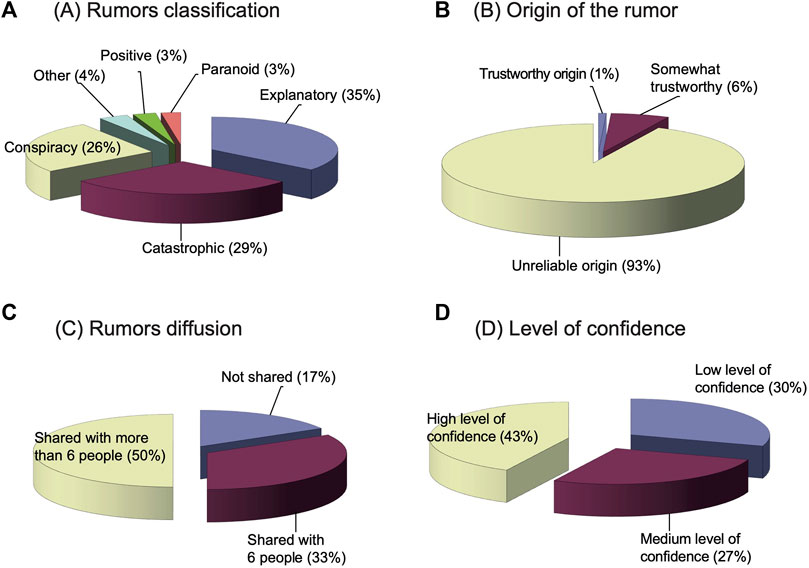
FIGURE 4. (A) Rumors classification. Collected rumors were classified in different categories based on their content. The most common are: explanatory (when the rumor focuses on the cause of the earthquake); catastrophic (when it suggests disruptive outcomes); conspiracy (when the emphasis is on alleged truth distortion by media or public institutions). (B). Reliability of the rumor’s source. We considered the institutions (such as the national Civil Protection Department) as trustworthy sources, while individuals and social media are considered unreliable. According to this classification, most rumors originated from unreliable sources. (C). Rumor diffusion indicates if and how much the reported rumor was shared with other people. Most rumors had ample diffusion. (D). The level of confidence, or trust, expresses how much the survey respondents believed in the reported rumor. Most rumors are accompanied by medium or high level of confidence.
The reporter’s degree of belief in the rumor was then computed according as:
Obtained T values range from 0.67 to 4 and were then classified into three levels of trust (low, medium and high), according to their T values within this range (Figure 4D). In most of the cases, the responders have a medium or high level of confidence in the rumor, while only 30% of the rumors are considered unreliable by the reporting person.
In order to identify the most frequent and dangerous topics, we used the indicators described above to compute the rumor strength (La Longa el al., 2014). According to Allport and Postman (1947), the strength of a rumor, R, is the product of the subject relevance, S, and its degree of ambiguity, A. In our case, the subject of all rumors is always the earthquake and, given its major impact on people’s lives at the time of the survey, we assigned S = 1 to all rumors. More details about the limits and strengths of this approach are provided below, in the Discussion section. Rumor’s ambiguity was computed as a sum of the scores attributed to the reliability of its source (O), its diffusion (D) and the confidence in the rumor itself (T):
Table 4 shows an excerpt of the collected rumors, together with their classification according to rumor type, origin, diffusion, trust and strength. The distribution of strength computed for all collected rumors is shown in Figure 5, while Figure 6 shows the distribution of rumors strength for different rumor subjects. The main topics are better described below, and include: the occurrence of anomalous phenomena (often considered possible precursors); the anthropogenic nature of the seismic sequence (supposedly triggered by fluid injection or extraction); the actual forecasts of imminent seismic events; and the existence of a conspiracy to conceal the real magnitude of seismic events. The figure shows that most of the strongest rumors (R = 9) fall in the subject of an “anthropogenic triggering” of earthquake, but strong rumors are present in all subjects. Table 5 lists all the strongest rumors collected (R = 9) and the recurrent topics are described in the discussion. Specific outreach content was devised to debunk these rumors.
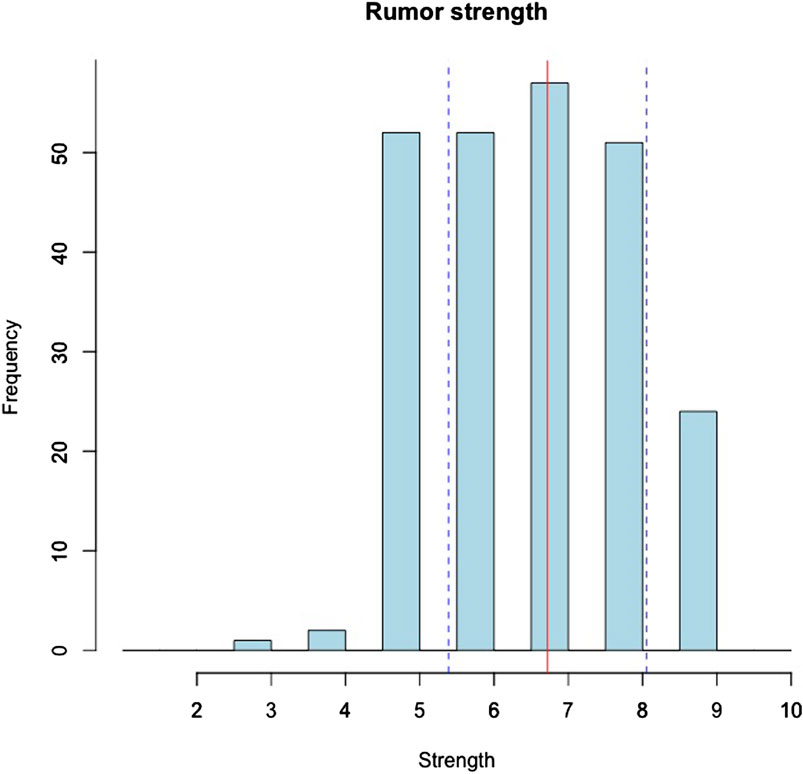
FIGURE 5. Rumor strength distribution. Vertical lines indicate the mean value (red) and standard deviation (blue, dashed). The strongest rumors (R = 9) are more than one standard deviation above the mean. They are listed in Table 5.
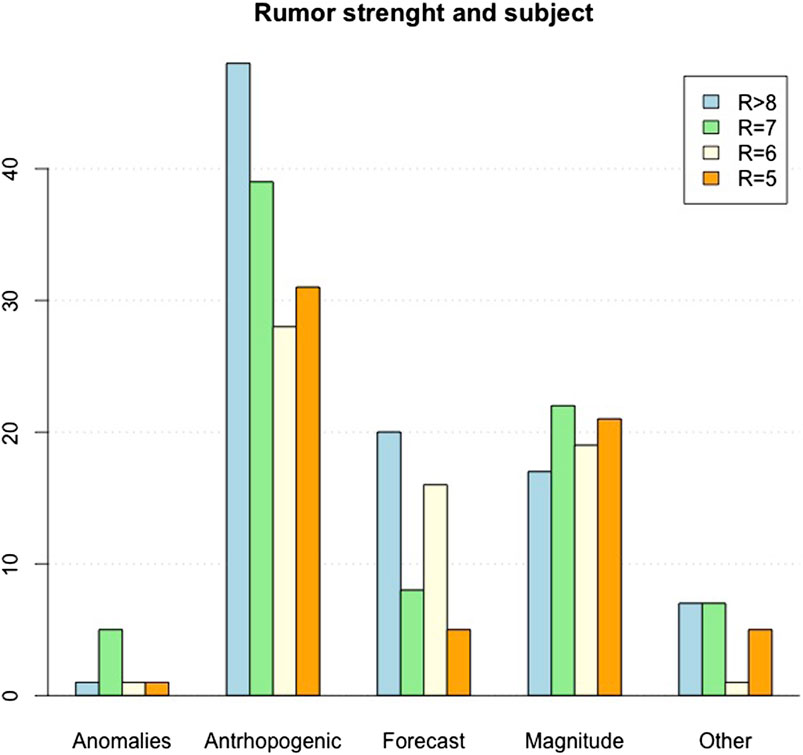
FIGURE 6. Distribution of rumors by strength and subject. Most of the rumors revolve around the anthropic nature (146 rumor reports, with an average strength of 7.0) and the supposedly hidden magnitude of the earthquakes (79 rumor reports, with average strength 6.7). Other rumors forecast future events (49 reports, average strength 7.3) or report the occurrence of anomalous phenomena, possibly related with the seismic sequence (8 reports, average strength 6.9). Twenty other rumors regard other topics (average strength 7.2).
3.3 Sharing scientific knowledge
Scientific information was made available in the form of maps, geologic sections, images and pictures of present and past seismic events, sketches or diagrams, written text. These materials were displayed or distributed on site as posters, booklets, leaflets, bookmarks, or projected on screen. The topics included details on the seismic sequence: maps showing the distribution of epicenters and their magnitude were particularly appreciated, together with maps illustrating the temporal evolution of the seismicity. We found it important to provide information on the geology and tectonic setting of the region: geological sections and maps were used to describe the thrust and folds buried underneath the Po plain sediments, and to justify the occurrence and position of the seismic sequence. Historical seismicity completed this geological picture of the region: maps showing the location and magnitude of the historical events allowed a comparison with the most recent activity, while the temporal distribution of the main sequence helped to constrain the timescale of tectonic plate interactions. In some specific cases, even written explanations proved useful. By keeping the text simple and concise, we could provide clear definitions for some relevant concepts that easily enter the public discourse about seismicity without being fully explained: people showed appreciation for bookmarks describing the difference between magnitude and intensity, or reporting the different grades of the historical Mercalli scale. After the controversy about the alleged anthropic origin of the earthquake, we also provided simple definitions for terms like “fracking” and “gas storage”, or explained the difference between “triggered seismicity” and “induced seismicity” (National Research Council 2013). These definitions were complemented by brief information on where (and since when) gas and oil are actually exploited or stored in the affected region. This kind of information gained a lot of attention during public events, despite their format (written explanations) apparently not appealing in a busy context. The short length of each body of text and the relevance of the topic at that time compensated for the little charm of the presentation.
Outreach efforts also focused on the phenomenon of shallow ground heating, commonly associated with diffuse degassing and bubbling well water (Capaccioni et al., 2015 and references therein). The occurrence of these phenomena captured the attention of a frightened population and has entered the local news several times since the 2012 sequence. Repeated episodes, sometimes accompanied by the death of small animals, fed the rumors about their potential role of these anomalies as precursors of impending seismic activity. The phenomenon, and the public attention about it, motivated a scientific study that was carried out by the University of Bologna, in collaboration with INGV (Capaccioni et al., 2015; Nespoli et al., 2015). This study showed that observed changes in ground temperature and gas composition are well explained by an exothermic oxidation of biogenic methane, which is abundant in the soil of the Po plain. This explanation does not imply a direct connection with the seismicity in the area, as the phenomenon occurs any time ambient conditions are favorable to methane oxidation. These scientific results were shared during public meetings, and commented during interviews released to local media and were described in a post on the institutional blog INGVterremoti (https://ingvterremoti.wordpress.com/2015/11/18/cosa-sappiamo-delle-terre-calde-di-medolla/).
4 Discussion
During the emergency phase, direct contact with the population and local institutions (administrative and health institutions, cultural associations … ) proved to be a strategic asset to ensure prompt and effective communication among the different stakeholders involved. These direct contacts had an important role in building mutual trust and dialog with the citizens.
The analysis of hearsay provides a special point of view on widespread fears and feelings about the earthquake. The relation proposed by Allport and Postman (1947) to compute the strength of rumors is certainly a good starting point for a preliminary assessment, even though this approach never went through a proper validation and critical analysis. One of the main criticisms risen about this approach regards the link between the topic of the rumor and its strength: according to some authors the importance and ambiguity of the theme cannot be considered a correct predictor of the rumor strength, as other features (such as the anxiety of the individuals involved) need to be considered. The criticism came primarily from the fact that the basic law of rumor postulated by Allport and Postman (1947) was not empirically grounded in any rumor research, but was adapted from the earlier work of McGregor (1938) on factors influencing predictive judgments (Rosnow, 1980). One difficulty with the basic law of rumor was that the factor of “importance” was elusive and not easy for researchers to operationalize. Also of concern was that the basic law of rumor ignored the emotional context of rumor. Based on subsequent research findings, Rosnow (1991, 2001) proposed a modified theory in which rumor-mongering is viewed as an attempt to deal with anxieties and uncertainties by generating and passing stories and suppositions that can explain things, address anxieties, and provide a rationale for behavior. At a moral level, we can usually distinguish between two types of rumors (Rosnow et al., 1986), those invoking hoped-for consequences (wish rumors) and those invoking feared or disappointing consequences (dread rumors), but finer distinctions within each category have been described as well (e.g., Difonzo & Bordia, 2000). Another addendum is that people have a tendency to spread rumors that they perceive as credible (even the most ridiculous stories), although when anxieties are intense, rumormongers are less likely to monitor the logic or plausibility of what they pass on to others (Rosnow, 2001). More recently, the extensive use of social media allows to gather significant amounts of data on rumors’ spreading. Large data sets are used to explore the rumors’ propagation across the community using natural language processing and the mathematical characteristics of complex networks (Cheng et al., 2021).
In our case, however, we limit our analysis following the Allport and Postman approach. The theme of earthquake in the aftermath of the seismic sequence certainly had a strong societal importance in the impacted area, and the individuals involved collectively suffered a high level of anxiety. We therefore applied the Allport and Postman formula focusing on the degree of ambiguity of the theme, and we used three indicators (source, diffusion and trust) to compute the rumor’s strength. This allowed us to identify and address the strongest rumors.
Most of the rumors that spread up immediately after the May 20 event focused on three main topics: the anthropogenic trigger of the seismic sequence, the prediction of forthcoming earthquakes, and the real (higher) magnitude of the events. The strongest rumors were carefully analyzed and debunked during public meetings and accompanied with sound scientific information.
4.1 The manmade earthquake
The theme of induced seismicity, in particular, stirred the public discussion for months, in a region where both the exploitation of geo-resources (mostly gas and minor oil) and gas storages within aquifers have been going on for decades. Not long before the seismic sequence started, a British corporation submitted a project to open a new gas storage facility near the town of Rivara, very close to the epicenter of the May 29 main shock. While the proposal was eventually rejected by local and regional authorities, the corporation could perform the required preliminary studies and geophysical prospecting. Sparse information on this industrial plan quickly merged with hearsay on the damage caused by fracking (which was never permitted in Italy), resulting in a confused picture where dangerous operations, involving gas and underground explosions, were carried out to benefit unspecified interests. Despite the lack of industrial activity at this specific site, the public concern was such that the regional authorities appointed a commission (ICHESE) to address the issue. The committee report concludes: “the Commission believes that it is highly unlikely that the activities of hydrocarbon exploitation at Mirandola and the geothermal activity at Casaglia have produced sufficient stress change to generate an ‘induced’ seismic event. While it cannot constitute proof, the current state of knowledge and all the processed and interpreted information does not allow ruling out the possibility that the actions involved in hydrocarbon exploitation in the Mirandola field may have contributed to ‘trigger’ the Emilia seismic activity”. The Committee continues by stating: “The study does not indicate any evidence which can associate the Emilia 2012 seismic activity to the operation activities in Spilamberto, Recovato, Minerbio and Casaglia fields, whereas it cannot be ruled out that the activities carried out in the Mirandola License area have had a triggering effect”. Finally, a brief note regards communication, suggesting that it is “critically important to implement an Outreach and Communication Program targeting local residents/administrative authorities so that they can gain confidence that operations are being managed optimally”. (ICHESE, 2014).
4.2 The earthquake about to happen
The rumor about a forthcoming major earthquake, predicted by various individuals or institutions, was also very common and spread out quickly after the main shocks on May 20 and 29. Our survey allowed us to identify three different versions of this catastrophic rumor. The first version is simple: a major shock is forecasted at a certain time. The rumor started on 31 May 2012 and circulated by word of mouth (telephone calls, texting and social media) in various urban areas (Bologna, Modena, Reggio Emilia, Mantova). In some cases, it was intentionally spread to allow actual profiteering, with people pretending to be civil protection operators and inviting citizens to evacuate their houses. In one case, the rumor led to the evacuation of the National Bank (Banca d’Italia) offices in Bologna. The resonance of this episode, which involved an authoritative institution, contributed to increase the psychosis, leaving abundant tracks in local press and social media. The strength of the rumor was such that the National Department of Civil Protection, the local public authorities and INGV had to release official statements to counter it. These actions lowered the public’s concerns and, together with the lack of seismicity at the predicted time, could finally downgrade the rumor to its actual nature. On 1 June 2012, the district attorney’s office announced the possible opening of a legal procedure for false alarm.
A second version of this rumor was more sophisticated and malicious, and was triggered by the so-called Northern Independent Center for Seismology (CSIS). CSIS created a blog and published a video forecasting a strong event between July 13 and 16, 2012, roughly in the same area hit by the May sequence and with magnitude between 4.5 and 6.1. The video gained about 40,000 visualizations on YouTube. Furthermore, in an attempt to gain credibility, the rumor was also published on a faked copy of a very popular blog, and thanking the author (Beppe Grillo) for posting the rumor.
The third version was more articulated and refers to an alleged earthquake prediction attributed to a parish priest in Massa Finalese. According to the rumor, the Virgin Mary appeared to the priest in a dream, announcing a devastating earthquake due to occur on Saturday, September 22, before 9 a.m. The rumor spread out quickly, especially around Ferrara, Modena, Bologna and Mantova. Different accounts attribute the vision to other priests in the area, or to a parishioner, and indicate different sites (Ferrara) or timing (September 29) for the predicted earthquake. The rumor was accompanied by hearsay according to which the parish priest was about to be arrested or beaten by angry citizens, all baseless news. Fact checking on the site allowed to tie the rumor to a homily by the priest in Massa Finalese, during a mass at the end of June 2012. In the homily, the priest considered that the worst period for the people hit by the seismic sequence in May, was going to be in September, with the re-opening of the schools and the resumption of the customary habits, and with lesser attention from the rest of the country.
The theme of earthquake prediction is closely associated with the issue of precursory phenomena. Hearsay (sometimes reinforced by local media) often highlighted the occurrence of “clear” signs of a forthcoming earthquake that accountable institutions (scientists, civil protection) either fail to recognize or do not address properly. Popular precursors include strange animal behavior or particular weather conditions. A particular phenomenon that periodically raises public attention in this area is the increment of ground temperature, sometimes associated with heated well water, bubbling with gas (Bonzi et al., 2017). In some cases, the combination of heat and gas can cause the death of crops or small animals (fishes, in particular). These episodes are rather common in the area: they are found in historical chronicles and even entered the local toponyms (such as “Terre Calde”, Hot lands). The long seismic sequence, however, promoted a renewed attention to the environment and its changes. Studies prompted by this renovated attention finally provided a scientific explanation for the phenomenon which is totally unrelated to the seismic sequence (Capaccioni et al., 2015; Nespoli et al., 2015). Nevertheless, these events are noted and still interpreted as potential precursors of future events.
4.3 The concealed magnitude of the events
The alleged falsification of the magnitude values by the institution in charge of seismic surveillance (INGV officials, in particular) is another persistent false news. This rumor had different versions, and stems from the observation that the magnitude values released by INGV may change with time or may not coincide with estimates performed by other, real or alleged, international agencies (from France, Poland, USA … ). Magnitude values reported abroad tended to be higher than those officially released by INGV (5.9), with values ranging from 6 (according to USGS) and 6.1 (provided by the European Agency CSEM-EMSC) up to 7.3. A version of the rumor mentions an amateur seismologist living in Novi, near Modena (or a pharmacist from Carpi, or Mirandola) who could “record” magnitude values well above 7, with his own two instruments located on the second floor in his house. According to all these rumors, INGV conspired to keep the magnitude below 6, as this would be a threshold value above which the State would fully cover for the damage. According to another version of the rumor, the Civil Protection promoted a major reformation just 1 month before the earthquake (perhaps knowing it was about to happen) only to prevent any compensation of the damage caused by natural disasters (this position being eventually retracted after the event, for mere political expediency). This hoax is not new and is directly tied to the L’Aquila earthquake, in 2009. At that time, coverage of full damage was only granted for those towns where the macroseismic intensity was found above the VI grade of the MCS scale. The confusion between magnitude and macroseismic intensity raised malicious suspicions against the normal process of magnitude manual revision that is always carried out immediately after major events.
5 Conclusion
In the aftermath of the 2012 seismic sequence in Northern Italy, INGV carried out an extended outreach effort to address the need for information of the impacted population.
The impacted community and their administrative authorities received these diverse outreach activities with great favor. Even though we cannot provide a quantitative measure of the efficacy of these activities, the overall response of the public suggests that timely outreach was both appreciated and needed.
The organization of several public meetings were possible thanks to the fruitful collaboration between the Civil Protection, INGV, the representatives of the local communities, the regional network of healthcare assistance, and the involvement of local volunteering associations. The combined efforts of these stakeholders contributed to the establishment and formalization of a good practice that promotes effective communication during emergencies. Preliminary contacts with local representatives proved particularly useful to identify the specific themes or topics that were of interest for each community. This allowed us to prepare and share scientific or psycho-social contents that were both relevant and timely for those participants, at the time of that particular meeting. An informal structure of the public encounter, that leaves ample time for questions and open discussion, and where the presentation of scientific information is limited to a brief, initial overview, proved to be successful in building a positive relationship among all participants. The identification of fears and beliefs allowed to contain and counter uncontrolled rumors and prevent them from driving the public discussion. Future studies, encompassing a quantitative analysis of rumors diffusion and the comparison with other case studies, such as the recent SARS-COV2 pandemic, will provide further tools to counter misinformation.
The approach based on multiple meetings with the population has been followed in 2014 (Camassi et al., 2014), in the occasion of minor seismic sequences, as in the case of Gubbio, when about 400 events (mostly with magnitude below 3) were recorded between December 2013 and December 2014. The strongest event (Mw 3.9) was recorded on the 22nd of December 2013 (Marzorati et al., 2016).
More recently, the Amatrice seismic sequence taking place in 2016, has proven more difficult to address in terms of emergency communication, given its dramatic consequences over a very wide area in Central Italy. The sequence initiated on the 24 August 2016 with the Mw 6.0 Amatrice earthquake and was followed on 26 October 2016 by the Mw 5.9 Visso earthquake; the largest event, the Mw 6.5 Norcia earthquake, occurred on the 30th October. Each mainshock was followed by sustained aftershock activity. In that occasion, 24 meetings were organized with several schools in the area, involving almost 1,500 teachers and parents. Despite greater logistic difficulties, the 2016 experience confirms the positive outcome of the open interaction between scientists, civil protection and local communities.
Planning and participating in these public encounters favored mutual trust and reciprocal knowledge, improving the coordination among the different components of the civil protection system. The direct interaction with the communities affected provided important hints for the development of outreach strategies that go well beyond the emergency phase, and contributed to defining the scientific contents for awareness campaigns and educational activities.
These experiences affected the way in which we develop educational materials, promoting a transition from science-oriented contents, reflecting our interests and our results, to society-oriented contents, designed to address people’s questions, accounting for their fears and understanding of geological processes.
Data availability statement
The raw data supporting the conclusion of this article will be made available by the authors, without undue reservation.
Ethics statement
Ethical review and approval was not required for the study on human participants in accordance with the local legislation and institutional requirements. Written informed consent from the participants was not required to participate in this study in accordance with the national legislation and the institutional requirements.
Author contributions
MC and FL conceived and organized the rumors’ collection and analysis. RC participated in the organization of the outreach campaign “Terremoto, parliamone insieme” and MT conceived and wrote the first draft of the manuscript. All authors participated in the public outreach campaign, attending some (MT) or many (MC, RC, EE, FL) meetings, collecting FAQs and elaborating outreach materials for the campaign. All authors were involved in the analysis of the rumors and contributed to writing the manuscript.
Funding
The study has benefited from the financial contribution of the Italian Presidenza del Consiglio dei ministri, Dipartimento della Protezione Civile within the DPC-INGV 2012-2021 Agreement.
Conflict of interest
The authors declare that the research was conducted in the absence of any commercial or financial relationships that could be construed as a potential conflict of interest.
Publisher’s note
All claims expressed in this article are solely those of the authors and do not necessarily represent those of their affiliated organizations, or those of the publisher, the editors and the reviewers. Any product that may be evaluated in this article, or claim that may be made by its manufacturer, is not guaranteed or endorsed by the publisher.
References
Alzanin, S. M., and Azmi, A. M. (2018). Detecting rumors in social media: A survey. Procedia Comput. Sci. 142, 294–300. doi:10.1016/j.procs.2018.10.495
Bonzi, L., Ferrari, V., Martinelli, G., Norelli, E., and Severi, P. (2017). Unusual geological phenomena in the emilia-romagna plain (Italy): Gas emissions from wells and the ground, Hot water wells, geomorphological variations. A review and an update of documented reports. Boll. Di Geofis. Teor. Ed. Appl. 58 (2), 87–102. doi:10.4430/bgta0193
Bordia, P., and Difonzo, N. (2004). Problem solving in social interactions on the internet: Rumor as social cognition. Soc. Psychol. Q. 67 (1), 33–49. doi:10.1177/019027250406700105
Bossu, R., Laurin, M., Mazet-Roux, G., Roussel, F., and Steed, R. (2015). The importance of smartphones as public earthquake-information tools and tools for the rapid engagement with eyewitnesses: A case study of the 2015 Nepal earthquake sequence. Seismol. Res. Lett. 86 (6), 1587–1592. doi:10.1785/0220150147
Camassi, R., Nostro, C., Bernardini, F., Crescimbene, M., Ercolani, E., La Longa, F., et al. (2014). Le attività informative dell’INGV in emergenza sismica: Motivazioni e ipotesi di sviluppo futuro. Proc. GNGTS 2, 328–335.
Capaccioni, B., Tassi, F., Cremonini, S., Sciarra, A., and Vaselli, O. (2015). Ground heating and methane oxidation processes at shallow depth in terre Calde di medolla (Italy): Observations and conceptual model. J. Geophys. Res. Solid Earth 120 (5), 3048–3064. doi:10.1002/2014JB011635
Cheng, M., Yin, C., Nazarian, S., and Bogdan, P. (2021). Deciphering the laws of social network-transcendent COVID-19 misinformation dynamics and implications for combating misinformation phenomena. Sci. Rep. 11 (1), 10424–10514. doi:10.1038/s41598-021-89202-7
Chorus, A. (1953). The basic law of rumor. J. Abnorm. Soc. Psychol. 48 (2), 313–314. doi:10.1037/h0060600
Difonzo, N., and Bordia, P. (2000). How top PR professionals handle hearsay: Corporate rumors, their effects, and strategies to manage them. Public Relat. Rev. 26 (2), 173–190. ISSN: 0363-8111. doi:10.1016/s0363-8111(00)00039-4
Doerr, B., Fouz, M., and Friedrich, T. (2012). Why rumors spread so quickly in social networks. Commun. ACM 55 (6), 70–75. doi:10.1145/2184319.2184338
Dominick, J. R. (2010). Dynamics of mass communication: Media in the digital age. New Dehli: Tata McGraw-Hill Education.
Fallou, L., Bossu, R., Landès, M., Roch, J., Roussel, F., Steed, R., et al. (2020). Citizen seismology without seismologists? Lessons learned from Mayotte leading to improved collaboration. Front. Commun. 5, 49. doi:10.3389/fcomm.2020.00049
Fallou, L., Marti, M., Dallo, I., and Corradini, M. (2022). How to fight earthquake misinformation: A communication guide. Seismol. Res. Lett. xx, 2418–2422. doi:10.1785/0220220086
Herriman, N. (2010). The great rumor mill: Gossip, mass media, and the ninja fear. J. Asian Stud. 69 (3), 723–748. doi:10.1017/S0021911810001488
Improta, L., Latorre, D., Margheriti, L., Nardi, A., Marchetti, A., Lombardi, A. M., et al. (2019). Multi-segment rupture of the 2016 Amatrice-Visso-Norcia seismic sequence (central Italy) constrained by the first high-quality catalog of Early Aftershocks. Sci. Rep. 9, 6921. doi:10.1038/s41598-019-43393-2
Inter-Agency Standing Committee (IASC) (2007). IASC Guidelines on Mental health and Psychosocial support in emergency settings. Geneva: IASC, 103. Available at: https://interagencystandingcommittee.org/system/files/2020-11/IASC%20Guidelines%20on%20Mental%20Health%20and%20Psychosocial%20Support%20in%20Emergency%20Settings%20%28English%29.pdf.
International Commission on Hydrocarbon Exploration and Seismicity in the Emilia Region (ICHESE) (2014). Report on the hydrocarbon exploration and seismicity in Emilia region. Available at: http://mappegis.regione.emilia-romagna.it/gstatico/documenti/ICHESE/ICHESE_Report.pdf.
La Longa, F., Crescimbene, M., and Camassi, R. (2014). Il contrasto di voci e dicerie sui terremoti del 20 e 29 Maggio 2012 in Pianura Padana. Proc. GNGTS 2, 401–409. ISBN 978-88-940442-2-5.
La Longa, F., and Crescimbene, M. (2009). La dimensione psicologica del terremoto che ha colpito l'Abruzzo. Relazione sull’attività di supporto svolta in Abruzzo dal 10/04/09 al 19/09/09. Roma: Rapporto INGV. Available at: http://www.earthprints.org/handle/2122/5869.
Lamontagne, M., and Flynn, B. W. (2014). Communications in the aftermath of a major earthquake: Bringing science to citizens to promote recovery. Seismol. Res. Lett. 85 (2), 561–565. doi:10.1785/0220130118
Lamontagne, M., and Goulet, C. (2018). Earthquake myths and false information: How to respond while avoiding a mud fight. Seismol. Res. Lett. 89 (6), 2411–2412. doi:10.1785/0220180258
Ma, R. (2008). Spread of SARS and war-related rumors through new media in China. Commun. Q. 56 (4), 376–391. doi:10.1080/01463370802448204
Martin, S. S., Bossu, R., Steed, R., Landès, M., Srinagesh, D., Srinivas, D., et al. (2021). When Punjab cried wolf: How a rumor triggered an “earthquake” in India. Seismol. Res. Lett. 92 (6), 3887–3898. doi:10.1785/0220210130
Marzorati, S., Cattaneo, M., Frapiccini, M., Monachesi, G., and Ladina, C. (2016). Recent seismicity before the 24 August 2016 Mw 6.0 central Italy earthquake as recorded by the ReSIICO seismic network. Ann. Geophys. Ann. Geophys. 59. Fast Track 5, 2016. doi:10.4401/ag-7191
McGregor, D. (1938). The major determinants of the prediction of social events. J. Abnorm. Soc. Psychol. 33 (2), 179–204. doi:10.1037/h0062931
Milgram, S. (1977). The individual in a social world: Essays and experiments. Reading, Mass: Addison-Wesley Pub., Pinter & Martin, 422.
Moretti, M., Nostro, C., Govoni, A.,2, Pignone, M., La Longa, F., Crescimbene, M., et al. (2011). L’intervento del Centro Operativo Emergenza Sismica in occasione del terremoto del 2009 a L’Aquila. Available at: http://istituto.ingv.it/images/collane-editoriali/quaderni-di-geofisica/quaderni-di-geofisica-2011/quaderno92.pdf.
National Research Council (2013). Induced seismicity potential in energy technologies. Washington, DC: The National Academies Press. doi:10.17226/13355
Nespoli, M., Todesco, M., Capaccioni, B., and Cremonini, S. (2015). Ground heating and methane oxidation processes at shallow depth in terre Calde di medolla (Italy): Numerical modeling. J. Geophys. Res. Solid Earth 120, 3065–3076. doi:10.1002/2014JB011636
Nostro, C., Camassi, R., Moretti, M., La Longa, F., Crescimbene, M., Govoni, A., et al. (2009). “Informazione e formazione in emergenza: Interventi a seguito del terremoto dell’Aquila del 6 aprile 2009,” in Proceedings of GNGTS - 28° convegno Nazionale. Trieste 16-19 novembre 2009. Available at: https://www.earth-prints.org/handle/2122/5925.
Pignone, M., Nostro, C., Amato, A., Casarotti, E., and Piromallo, C. (2012). The INGVterremoti blog: A new communication tool to improve earthquake information during the Po plain seismic sequence. Ann. Geophys. 55 (4). doi:10.4401/ag-6179
Qin, Z., Cai, J., and Wangchen, H. (2015). How rumors spread and stop over social media: A multi-layered communication model and empirical analysis. Commun. Assoc. Inf. Syst. 36. doi:10.17705/1CAIS.03620
Rosnow, R. L. (1991). Inside rumor: A personal journey. Am. Psychol. 46 (5), 484–496. doi:10.1037/0003-066X.46.5.484
Rosnow, R. L. (1980). Psychology of rumor reconsidered. Psychol. Bull. 87 (3), 578–591. doi:10.1037/0033-2909.87.3.578
Rosnow, R. L. (2001). “Rumor and gossip in interpersonal interaction and beyond: A social exchange perspective,” in Behaving badly: Aversive behaviors in interpersonal relationships (Washington: American Psychological Association), 203–232. doi:10.1037/10365-008
Rosnow, R. L., Yost, J. H., and Esposito, J. L. (1986). Belief in rumor and likelihood of rumor transmission. Lang. Commun. 6 (3), 189–194. doi:10.1016/0271-5309(86)90022-4
Wendling, C., Radisch, J., and Jacobzone, S. (2013). The use of social media in risk and crisis communication, No 24, OECD working papers on public governance. Paris: OECD Publishing. Available at: https://EconPapers.repec.org/RePEc:oec:govaaa:24-en.
Keywords: earthquake, rumor, 2012 emilia earthquakes (Italy), science communication, risk perception
Citation: Crescimbene M, Todesco M, La Longa F, Ercolani E and Camassi R (2023) The whole story: Rumors and science communication in the aftermath of 2012 Emilia seismic sequence. Front. Earth Sci. 10:1002648. doi: 10.3389/feart.2022.1002648
Received: 27 July 2022; Accepted: 30 December 2022;
Published: 12 January 2023.
Edited by:
Eric M. Thompson, United States Geological Survey (USGS), United StatesReviewed by:
Remy Bossu, European-Mediterranean Seismological Centre, FranceRaffaele De Risi, University of Bristol, United Kingdom
Paul Bogdan, University of Southern California, United States
Copyright © 2023 Crescimbene, Todesco, La Longa, Ercolani and Camassi. This is an open-access article distributed under the terms of the Creative Commons Attribution License (CC BY). The use, distribution or reproduction in other forums is permitted, provided the original author(s) and the copyright owner(s) are credited and that the original publication in this journal is cited, in accordance with accepted academic practice. No use, distribution or reproduction is permitted which does not comply with these terms.
*Correspondence: Micol Todesco, bWljb2wudG9kZXNjb0Bpbmd2Lml0
 Massimo Crescimbene
Massimo Crescimbene Micol Todesco
Micol Todesco Federica La Longa1
Federica La Longa1